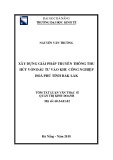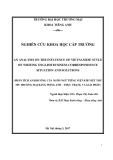
HỘI NGHỊ KHOA HỌC CHẨN ĐOÁN HÌNH ẢNH TP.HCM MỞ RỘNG XI -2024
RSHCM 2024
Tổng quan về Bệnh phổi mô kẽ
PGS TS BS Lê Thượng Vũ
Trưởng Phân môn Phổi, BM Nội, ĐHYD TPHCM
Trưởng khoa Hô hấp BV ĐHYD TPHCM
Phiên Hình ảnh học

Nội dung
1.Khái niệm, định nghĩa, dịch tễ
2.Chẩn đoán Bệnh phỗi kẽ
3.Điều trị Bệnh phỗi kẽ
4.Tóm tắt
2

Khái niệm và Định nghĩa
ILA ILD
Hatabu, H. (2020). Interstitial lung abnormalities detected incidentally on CT: a Position Paper from the Fleischner Society.
The Lancet Respiratory Medicine,2020 doi:10.1016/s2213-2600(20)30168-5

Khái niệm và Định nghĩa
Bệnh phổi kẽ là một nhóm bệnh gồm
nhiều rối loạn đặc trưng bởi tổn thương
nhu mô phổi lan tỏa
Tổn thương mô kẽ phổi do hai quá trình:
thâm nhiễm các tế bào viêm và xơ (loại
trừ ung thư và nhiễm trùng) dẫn đến thay
đổi trong phế nang và khí đạo
Bệnh thường được phân loại bằng lâm
sàng, hình ảnh học và mô bệnh học

The definite diagnosis of IPF in the presence
of a
surgical biopsy showing UIP includes the
following:
1. Exclusion of other known causes of
interstitial lung disease such as drug
toxicities, environmental exposures, and
collagen vascular diseases
2. Abnormal pulmonary function studies that
include evidence of restriction (reduced VC
often with an increased
FEV1/FVC ratio) and/or impaired gas
exchange [increased
AaPO2 (alveolar–arterial pressure difference
for O2) with rest or exercise or decreased
DLCO (diffusing capacity of the lung for CO)]
3. Abnormalities (described below) on
conventional chest radiographs or high-
resolution computed tomography (HRCT)
scans
The presence of all of the following major diagnostic
criteria as well as at least three of the four minor
criteria increases the likelihood of a correct clinical
diagnosis of IPF
Major Criteria
• Exclusion of other known causes of ILD, such as certain
drug toxicities, environmental exposures, and connective
tissue diseases
• Abnormal pulmonary function studies that include evidence of
restriction (reduced VC often with an increased
FEV1/FVC ratio) and impaired gas exchange [increased
AaPO2 with rest or exercise or decreased DLCO]
• Bibasilar reticular abnormalities with minimal ground
glass opacities on HRCT scans Transbronchial lung biopsy or
bronchoalveolar lavage (BAL) showing no features to support an
alternative diagnosis
Minor Criteria
• Age > 50 yr
• Insidious onset of otherwise unexplained dyspnea on
exertion
• Duration of illness > 3 mo
• Bibasilar, inspiratory crackles (dry or “Velcro” type in
quality)
5
ATS/ERS Am J Respir Crit Care Med 2000
hinhanhykhoa.com




![PET/CT trong ung thư phổi: Báo cáo [Năm]](https://cdn.tailieu.vn/images/document/thumbnail/2024/20240705/sanhobien01/135x160/8121720150427.jpg)





















